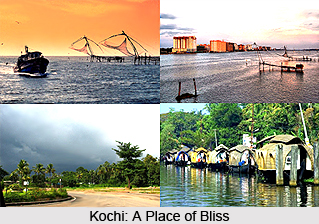Kochi (Cochin) is an ancient city of the Indian state Kerala and is one of the largest ports and a major naval base of India. It is well known for its beautiful setting on a cluster of islands and narrow peninsulas. The eclecticism of Kerala is reflected through the fascinating beauty of Kochi.
 The oldest church of India is situated in Kochi. One can see the beautiful winding streets crammed with 500-year-old Portuguese houses all around the town Kochi. The other attractive things of Kochi include the cantilevered Chinese fishing nets, a Jewish community whose roots go back to the diaspora, a 16th century synagogue, and a palace built by the Portuguese and given to the Raja of Cochin. This Portuguese palace was later reconstructed by the Dutch, which contains some of India`s most beautiful murals.
The oldest church of India is situated in Kochi. One can see the beautiful winding streets crammed with 500-year-old Portuguese houses all around the town Kochi. The other attractive things of Kochi include the cantilevered Chinese fishing nets, a Jewish community whose roots go back to the diaspora, a 16th century synagogue, and a palace built by the Portuguese and given to the Raja of Cochin. This Portuguese palace was later reconstructed by the Dutch, which contains some of India`s most beautiful murals.
Kochi is said to be the first and foremost a trading city in India. In the 1st century AD, Arab and Jewish spice traders had settled here. Under the patronage of the local Rajas or kings, these communities developed in the trading business with the Middle East and eastern Mediterranean countries.
Kochi became well known in the 14th century AD when the ancient port of Cranganore (Kondungallur) started. It increased the business opportunities of Kochi with other parts of the country. Thus, Kochi became the most important port on the Malabar Coast.
The spice trade in Kochi became so popular that the Rajas of Kochi started competing with the Zamorins of Calicut for territory. This rivalry made the entry of the Portuguese easy in early 1500. In 1663, the Dutch took over the domination in spice trade in Kochi but just after a century, the British took over the control.
The town of Kochi includes the mainland Ernakulam, the islands of Wellington, Bolgatty and Gundu in the harbour, Fort Cochin and Mattanchery on the Southern Peninsula and Vypean Island, north of Fort Cochin. All these parts are connected by water. Ernakulam is also linked by bridges with other parts of the island.
India`s oldest European built church called St. Francis Church is located within the Fort Cochin. This church was constructed in 1503 by Portuguese Franciscan friars who came with the expedition led by Pedro of Alvaraz Cabral. The great traveller Vasco da Gama died in Kochi in 1524. He was buried here for 14 years and later his remains were transferred to Lisbon in Portugal. The tombstone of Vasco da Gama can yet be seen inside the church, which possesses rope-operated punkas or fans.
The Portuguese built the Santa Cruz Basilica church, which is an important historical structure. The British destroyed this church in 1795. The church was reconstructed in 1887 by Bishop Dom Gomez Ferreira. The majestic Pallipuram Fort is also situated in Kochi. If one wishes to enjoy, the typical Kerala village with paddy fields and coconut groves then Vypean is the perfect destination. There, one can also see the fishing nets erected between 1350 and 1450 by traders from the court of Kublai Khan. These are set up on teak wood and bamboo poles. But still it looks like being lowered into the sea and the catch being brought to the Vasco da Gama Square.
The official residence of the royal family of Cochin is situated at 10 km away from Kochi in the Hill palace. This ancient palace of Kochi has 49 buildings, which followed the traditional architectural style of Kerala. There is also a museum in the palace. The palace museum contains beds, paintings carvings, and epigraphs of the Kochi royal family. The furniture and the throne of the king can be seen in the Paliathachan gallery of the museum. Other interesting items of the museum include the antique pieces of pottery, ceramic vases from China and Japan, kudaikal, tomb stone (thoppikallu), hood stones, menhirs in granite and memorials from rock cut caves of Iron Age and wooden temple models.



















